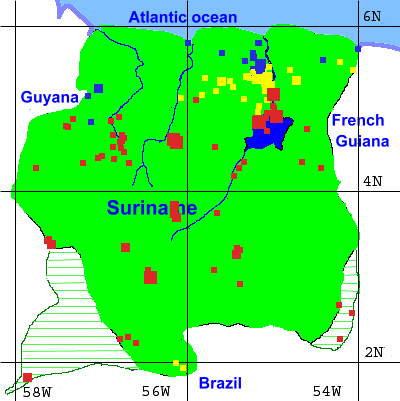| Distribution |

Each small square indicates the observation of at least one (group) of these birds, the medium ones at least four observations on different days and the largest ones ten or more. The color of each square indicates: blue for coastal area, yellow for savanna and red for rainforest.
Not all places in Suriname have been equally often visited by birders, so the distribution of the squares gives an indication of the whereabouts of the birds, but also of the birders. Some places deep in the south have no reported bird observations, by experienced birders, within 60 kilometer.
|
|
| Abundance in different areas |
| coastal zone (blue dots on the map) : |
 |
| northern savannas (yellow dots (in the north)) : |
 |
| rainforest under 400 m (red dots) : |
 |
| rainforest above 400 m (red dots) : |
 |
| Sipaliwini savanna (yellow dots (in the south)) : |
 |
A blank is shown if not convincingly reported in the zone.
Data interpreted by Arie Spaans, Otte Ottema and Jan Hein Ribot.
|
| Names |
| Scientific name: |
Dacnis cayana |
| Order: |
Passeriformes |
| Family: |
Thraupidae, 56 in Suriname |
| Dutch: |
Blauwe pitpit |
| English: |
Blue Dacnis |
| Sranan ('Surinamese'): |
Blauwe pitpit (male), Groene pitpit (female) |
| Guyana: |
|
| Papiamento: |
|
| Spanish (Venezuela): |
Mielero turquesa |
| Portugese (Brazil): |
Saí-azul, Saíra |
| Arowak: |
|
| Carib: |
|
| French: |
Dacnis blue |
|
 Blue Dacnis (Dacnis cayana)
Blue Dacnis (Dacnis cayana)
 Blue Dacnis (Dacnis cayana)
Blue Dacnis (Dacnis cayana)